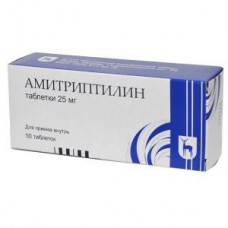Expiration date: 06/2026
Composition and form of issue:
1 tablet contains amitriptyline hydrochloride 0, 025 g, as well as auxiliary substances (milk sugar, corn starch, MCC, Aerosil, medical gelatin, calcium stearate) in a contour cell package of 10 PCs., in a cardboard pack of 5 packages.
1 ml of solution for injection-10 mg, as well as auxiliary substances (glucose, sodium chloride, hydrochloric acid solution, benzethonium chloride, water for injection) in ampoules of 2 ml, in a pallet of 5 PCs., in a cardboard pack of 2 pallets or 2 ml ampoules, in a contour cell package of 5 PCs., in a box of 100 packages.
Characteristic:
Tablets from white with a grayish or white with a creamy shade to white with a cream shade of color.
Transparent colorless liquid.
Pharmacological action:
Inhibits the reverse neuronal capture of catecholamines (norepinephrine, dopamine) and serotonin in the Central nervous system. Blocks muscarinic cholinergic receptors in the Central nervous system and the periphery, has peripheral antihistamine (H1) and antiadrenergic properties. It has a pronounced thymoanaleptic and sedative effect. It has anti-analgic (Central analgesic), anti-ulcer and anti-bulimic effect, effective for night urinary incontinence.
Pharmacokinetics:
Absorption-high. Bioavailability in different ways of administration is 30-62%. The time to reach C Max after ingestion — 2-7, 7 h. Volume of distribution 5-10 l/kg. Effective therapeutic blood levels for amitriptyline — 50-250 ng/ml, although — 50-150 ng/ml Cmax in blood plasma — 0, 04-0, 16 µg/ml. Passes through gistogematicalkie barriers, including GEB (including nortriptyline). Creates concentrations in tissues exceeding plasma concentrations. Plasma protein binding-92-96%. It is metabolized in the liver (demethylation, hydroxylation) with the formation of active — nortriptyline, 10-hydroxy-amitriptyline and inactive metabolites. T1/2 from blood plasma — 10 to 28 h for amitriptyline and 16-80 hours although. It is excreted by kidneys (80%), partially with bile. Complete excretion-within 7-14 days. It passes through the placental barrier, penetrates into breast milk in concentrations similar to plasma.
Description of pharmacological action:
Antidepressant action develops within 2-4 weeks after the start of application.
Indications:
Tablets.
Depression of any etiology (especially effective in anxiety and depression), mixed emotional disorders and behavioral disorders, phobic disorders, children's enuresis (except for children with hypotonic bladder), psychogenic anorexia, bulimic neurosis, chronic pain syndrome (neurogenic nature), migraine prevention.
Solution for injection.
Severe depression (especially effective in anxiety and depression).
Contraindications:
Hypersensitivity, heart failure decompensation, acute and recovery phase of myocardial infarction, violations conductivity cardiac muscles, severe hypertension, acute diseases of the liver and kidney with severe dysfunction of, blood disease, stomach ulcer and duodenal ulcer in the acute stage, prostate hypertrophy, bladder atony, pyloric stenosis, paralytic ileus, concurrent treatment with MAO inhibitors, pregnancy, breast-feeding, age up to 6 years.
With caution should be used in persons suffering from alcoholism, with bronchial asthma, manic depressive psychosis, epilepsy, with the oppression of bone marrow hematopoiesis, hyperthyroidism, angina pectoris and heart failure, closed-angle glaucoma, intraocular hypertension, schizophrenia.
Use during pregnancy and breast-feeding:
Contraindicated in pregnancy. At the time of treatment should stop breastfeeding.
Side effect:
Cholinolytic effects: accommodation paresis, blurred vision, increased intraocular pressure, dry mouth, constipation, intestinal obstruction, urinary retention, fever (usually after adaptation to the drug or lower doses).
From the nervous system and sensory organs: headache, ataxia, fatigue, weakness, irritability, dizziness, noise in ears, drowsiness or insomnia, impaired concentration, nightmares, dysarthria, confusion, hallucinations, motor agitation, disorientation, tremor, paresthesia, peripheral neuropathy, changes on EEG are rarely — extrapyramidal disorders, convulsions, anxiety.
From the cardiovascular system and blood (hematopoiesis, hemostasis): tachycardia, arrhythmia, conduction disorders, lability of blood PRESSURE, expansion of the QRS complex on ECG (violation of intraventricular conduction), symptoms of heart failure, fainting, changes in blood picture, including agranulocytosis, leukopenia, eosinophilia, thrombocytopenia, purpura.
From the digestive tract: nausea, vomiting, heartburn, anorexia, stomatitis, taste disorders, darkening of the tongue, discomfort in the epigastrium, gastralgia, increased activity of hepatic transaminases rarely — cholestatic jaundice, diarrhea.
From the metabolism: galactorrhea, changes in ADH secretion, rarely-Hypo-or hyperglycemia, glucose tolerance.
From the genitourinary system: changes in libido, potency, testicular edema, glucosuria, pollakiuria.
Allergic reactions: skin rash, itching, photosensitization, angioedema, urticaria.
Other: increase in breast size in men and women, hair loss, lymph node enlargement, weight gain (with long-term use), sweating, withdrawal syndrome: headache, nausea, vomiting, diarrhea, irritability, sleep disturbance with bright, unusual dreams, increased excitability (after long-term treatment, especially in high doses, with a sharp discontinuation of the drug).
Drug interaction:
Increases the depressing effect on the Central nervous system of neuroleptics, sedatives and sleeping pills, anticonvulsants, analgesics, drugs for anesthesia, alcohol shows synergy in interaction with other antidepressants. When combined with neuroleptics and / or anticholinergics, it is possible to develop a febrile temperature reaction, paralytic intestinal obstruction. Potentiates the hypertensive effects of catecholamines and other adrenostimulants, which increases the risk of heart rhythm disorders, tachycardia, severe hypertension. Can reduce the antihypertensive effect of guanethidine and drugs with a similar mechanism of action, as well as weaken the effect of anticonvulsants. While the use of anticoagulants-coumarin derivatives or indandion — may increase anticoagulant activity of the latter. Enhances the effect of antiparkinsonian agents. Cimetidine increases plasma concentrations of amitriptyline with the possible development of toxic effects, inducers of microsomal liver enzymes (barbiturates, carbamazepine) — reduce. Quinidine slows down the metabolism of amitriptyline, estrogens containing oral contraceptives can increase bioavailability. Combined use with disulfiram and other acetaldehyde dehydrogenase inhibitors can provoke delirium. Pimozide and probucol may exacerbate heart arrhythmias. Amitriptyline may increase depression caused by glucocorticoids. When combined with drugs for the treatment of thyrotoxicosis increases the risk of agranulocytosis.
Incompatible with MAO inhibitors (possible death).
Dosage and administration:
Inside (during or after eating), in/m. Initial dose the ingestion of 0, 05-0, 075 g/day in 2-3 doses, then gradually increase the dose to 0, 025-0, 05 g to produce the desired antidepressant effect. The optimal daily dose is 0, 15-0, 2 g (the main part is prescribed for the night).
In severe depression, resistant to therapy, the dose is increased to 0, 3 g/day or more to the maximum tolerated (for outpatient patients, the maximum dose is 0, 15 g / day). In this case, it is advisable to start treatment with/m or/in (slow) administration at a dose of 10-30 mg to 4 times a day, gradually increasing the dose after 1-2 weeks pass to the drug inside. Within 2-4 weeks the dose is gradually and slowly decrease, in the case of occurrence of symptoms of depression at decrease in doses it is necessary to return to the previous dose. If the patient's condition does not improve within 3-4 weeks, then further therapy is impractical.
Elderly patients in outpatient practice-0, 025-0, 05-0, 1 (maximum) g/day in divided doses or 1 time per day at night.
For the prevention of migraine and chronic pain of neurogenic nature (including prolonged headache) — from 0, 0125-0, 025 to 0, 1 g/day.
When enuresis children over 6 years-0, 0125-0, 025 g before bedtime (no more than 0, 0025 g/kg).
Overdose:
Symptoms: drowsiness, disorientation, confusion, pupil dilation, fever, shortness of breath, dysarthria, excitation, hallucinations, convulsive seizures, muscle rigidity, stupor, coma, vomiting, arrhythmia, hypotension, heart failure, respiratory depression.
Treatment: discontinuation of therapy, gastric lavage, fluid infusion, symptomatic therapy, maintenance of blood pressure AND water-electrolyte balance, monitoring of cardiovascular activity (ECG) for 5 days, as relapse can occur after 48 hours and later. Hemodialysis and forced diuresis are ineffective.
Precautionary measures:
Amitriptyline intake is possible not earlier than 14 days after the cancellation of MAO inhibitors. In doses above 150 mg / day reduces the threshold of convulsive activity, so you should consider the possibility of seizures in patients with a history of those and patients prone to convulsive seizures due to age or injury. Treatment of elderly patients should be carefully monitored and with the use of minimal doses, increased only gradually to avoid the development of delirious disorders, hypomania and other complications. In patients with manic-depressive psychosis can cause the transition of the depressive phase into manic.
During treatment, it is prohibited to drive vehicles, maintain machinery and perform work that requires increased concentration of attention, as well as alcohol.



